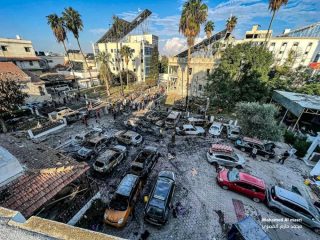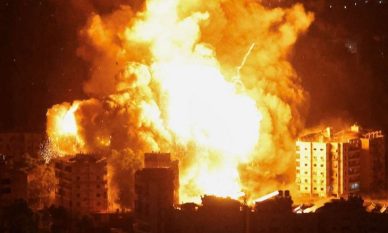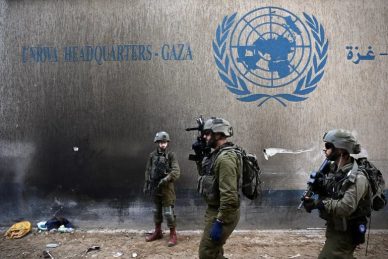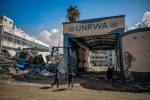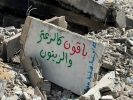KHAN YUNIS, (PIC)
When one wanders through the city of Khan Yunis in the southern Gaza Strip, it creeps into their imagination that they are strolling through a city of ghosts. The immense destruction caused by the Israeli war machine is barely imaginable to the mind.
Khan Yunis endured a brutal Israeli aggression for five months, resulting in destruction comparable to what German cities experienced during World War II. The city’s face has been changed, turning it into a pile of rubble.
The Israeli occupation forces believed that their destruction of the city would change the consciousness of its people and turn them against the resistance. However, that did not happen. The residents returned to the city, proud of their resistance and steadfastness against the occupation.
Widespread destruction
According to the International Rescue Committee, Khan Yunis, the second-largest city in the Gaza Strip, which was home to over 200,000 people before the Israeli aggression, has now become a ghost town.
Following a visit by an assessment mission to the area on April 25th, the organization issued a press statement stating that every building seen by the mission members was either severely damaged or reduced to rubble. The statement also noted that some people have returned to protect what remained of their belongings.
The scenes of total destruction were also observed by the United Nations Relief and Works Agency (UNRWA) and the United Nations Office for the Coordination of Humanitarian Affairs (OCHA) during separate visits to the city of Gaza.
A temporary assessment conducted by the World Bank indicated that over 60% of residential buildings and nearly 80% of commercial facilities in the Gaza Strip have been damaged or destroyed between October 2023 and January 2024. The majority of the damage, around 80%, is concentrated in Gaza City, North Gaza, and Khan Yunis governorates.
No area in the city of Khan Yunis was spared from destruction. All neighborhoods were subjected to bombardment and destruction, which eradicated many aspects of life in the city.
Khan Yunis Refugee Camp, known as “the camp” by the people of Gaza, is one of the most densely populated areas in the city and suffered the most significant destruction. Reports indicate that the Israeli forces nearly completely destroyed the refugee camp, with the most concentrated damage in the areas of Al-Shafi’i Mosque and Al-Dahra.
Block J in the camp also experienced immense destruction that words fail to describe adequately, and even cameras may struggle to capture the full extent of the devastation.
Nasser Hospital, the second-largest hospital in the Gaza Strip in terms of size and capabilities, was the scene of atrocious Israeli crimes on two occasions. The occupation forces destroyed some hospital facilities and arrested hundreds of displaced people and medical staff. Mass graves were also discovered, revealing the extent of the human tragedy.
Amal Neighborhood, described by the occupation as a stronghold of the Qassam Brigades, was targeted for deliberate destruction. Israeli war machines relentlessly bombarded and nearly completely destroyed the neighborhood, including its prominent landmarks such as streets, parks, and shops. Even the mosques did not escape the brutality of the Israeli aggression, as the occupation forces destroyed major mosques in the neighborhood, including Al-Rahma Mosque, Hassan al-Banna Mosque, and Abu Dharr Mosque.
As part of targeting healthcare facilities, Al-Amal Hospital in the same neighborhood witnessed horrifying crimes. The hospital, affiliated with the Palestinian Red Crescent Society, was rendered inoperable due to the occupation forces’ actions.
Al-Balad District, the heart and economic hub of the city, was a target of the destruction machine. All commercial stores were subjected to bombardment, reducing them to rubble. The war machine partially destroyed Jasser Building, one of the city’s prominent landmarks, in addition to completely destroying Al-Farra Tower, one of the tallest buildings in the city. The large mosque, which had been rebuilt months before the war, was also completely destroyed.
Hamad City, a neighborhood established years ago with Qatari funding to accommodate young couples, was a target of a military operation that caused immense destruction in the city. Surrounding neighborhoods like Al-Qarara, Al-Satr Al-Gharbi, and Al-Satr Al-Sharqi also suffered extensive damage, documented by camera lenses in indescribable scenes.
The eastern suburbs of Khan Yunis, such as Bani Suheila, Abasan, Khuza’a, and Ma’an, also became a battlefield, where Israel left no trace of the picturesque areas in eastern Khan Yunis. The southern neighborhoods of the city, such as Al-Nimsawi, Al-Batin Al-Samin, Qizan Al-Najjar, and Qizan Abu Rashwan, were not spared from the Israeli shelling, resulting in massive destruction.
In conclusion, the occupation army succeeded in destroying buildings in Khan Yunis during its invasion, but it failed to kill the will of its inhabitants and their love for life.


